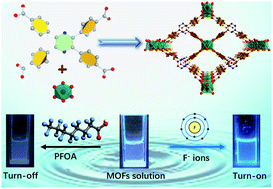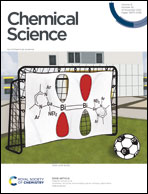A switchable sensor and scavenger: detection and removal of fluorinated chemical species by a luminescent metal–organic framework†
Abstract
Fluorosis has been regarded as a worldwide disease that seriously diminishes the quality of life through skeletal embrittlement and hepatic damage. Effective detection and removal of fluorinated chemical species such as fluoride ions (F−) and perfluorooctanoic acid (PFOA) from drinking water are of great importance for the sake of human health. Aiming to develop water-stable, highly selective and sensitive fluorine sensors, we have designed a new luminescent MOF In(tcpp) using a chromophore ligand 2,3,5,6-tetrakis(4-carboxyphenyl)pyrazine (H4tcpp). In(tcpp) exhibits high sensitivity and selectivity for turn-on detection of F− and turn-off detection of PFOA with a detection limit of 1.3 μg L−1 and 19 μg L−1, respectively. In(tcpp) also shows high recyclability and can be reused multiple times for F− detection. The mechanisms of interaction between In(tcpp) and the analytes are investigated by several experiments and DFT calculations. These studies reveal insightful information concerning the nature of F− and PFOA binding within the MOF structure. In addition, In(tcpp) also acts as an efficient adsorbent for the removal of F− (36.7 mg g−1) and PFOA (980.0 mg g−1). It is the first material that is not only capable of switchable sensing of F− and PFOA but also competent for removing the pollutants via different functional groups.

- This article is part of the themed collection: Metal organic frameworks and porous polymers


 Please wait while we load your content...
Please wait while we load your content...